Looking Back on History | Baoshan Elements that Played a Role in Developing Shanghai into a Modern City
The magazine Qiushi released an important article, entitled “Building Archeology with Chinese Characteristics and Styles to Better Understand the Long-Standing and Profound Chinese Culture”, written by President Xi Jinping on its 23rd issue published on December 1, 2020. As emphasized by President Xi Jinping in this article, “China is experiencing wide-ranging and deep-going social transformation and is conducting great innovations in practice to uphold and develop socialism with Chinese characteristics. Our innovations in practice must be based on the law of the development of history and follow the right direction of history.” “Throughout history, the Chinese nation has developed great spirits and traditional culture, which constitutes the cultural genes that have been inherited generation after generation. They are the great spiritual power that drives the realization of the great rejuvenation of the Chinese nation and need to be carried forward based on new conditions.”
Wusong Railway, Wusong Lighthouse, Wusong Datum...these Baoshan elements played a role in developing Shanghai into a modern city. They are valuable results of and vivid evidence for the efforts made by Baoshan in the municipal development over the last century and have had a great influence on the urban construction of Shanghai and beyond. They not only are valuable spiritual legacy created by our ancestors, but also constitute the new development position established by the CPC Shanghai Municipal Committee for Baoshan as they will provide powerful spiritual stimulation for building the district into the main position of the scientific and technological innovation center of Shanghai.
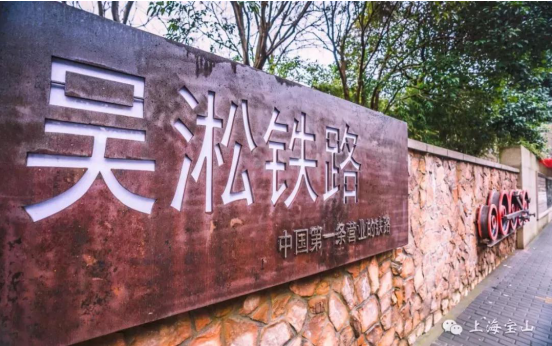
Wusong Railway
China’s First Business-Operated Railway Born in Baoshan
Hailed by Marx as “the driver of modern industries, railways are an important milestone in the advancement of human civilization. In 1814, railways and steam locomotives were first developed in the UK where the Industrial Revolution was in full swing.
On July 3, 1876 (leap May 12 in the traditional Chinese calendar), Wusong Railway was built between Shanghai and Baoshan, becoming the first business-operated railroad in the history of China.
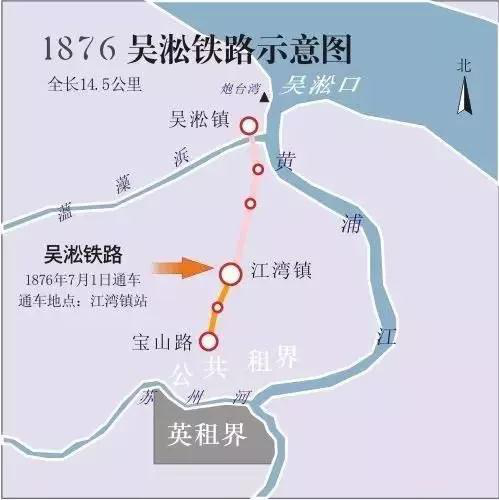
Looking back, Chinese railways experienced a difficult course of development full of setbacks and helpless choices, largely due to the environment of the Old China. After the New China was established, railways returned to the hands of the people and regained momentum. Since the reform and opening-up, especially since the 18th CPC National Congress, Chinese railways have embarked on a new era of rapid and healthy development in a sustainable way. High-speed railways, subways, and light rails have been springing up across the country, becoming the driver for the rapid and healthy development of the Chinese economy and society.
According to research, as early as 1866, Sir Thomas Francis Wade, then British minister in China, proposed to the government of the Qing Dynasty that a railway should be built between Wusong and Shanghai to facilitate the seal-rail transport of large vessels since the blocked Wusong-Shanghai section of Huangpu River made it hard for large vessels to travel to the center of Shanghai. At the time, the Qing government was suspicious about railways, so it did not approve the request of Wade.
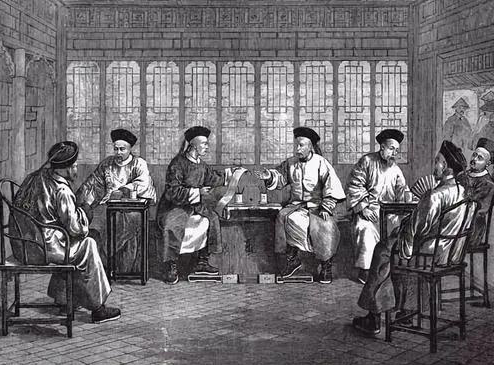
In around 1874, Jardine Matheson, a British company based in Shanghai, claimed that it would build a “road” between Wusong and Shanghai, for which it had set up a company named Wusong Road Company. After gaining approval from the Qing government, the company acquired the land from the north of Shanghai concessions to Wusong. At the end of 1875, Wusong Road Company imported steel rails and locomotives in the deceiving name of “ironware for building the vehicle road”. At the beginning of February 1876, the rails had been laid near the then Xu’s Family Garden.
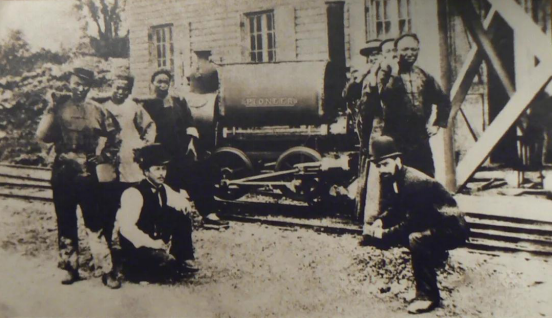
A photo of British engineers and Chinese porters taken in 1876 who were building Wusong Railway
No need to wait for the completion of the railway and seeing trains running on it, the construction vehicles (used for transporting sleepers and gravels) already triggered wide curiosity among the people at the time. Not only local people grew a liking for the construction scene, but people from places far away also liked watching the scene despite the long travel. Every day, thousands of people would come to the construction site by riding a carriage, taking a sedan chair, or taking a rickshaw; small fruit and dim sum peddlers also moved their stalls to the construction site, creating a market fair there.
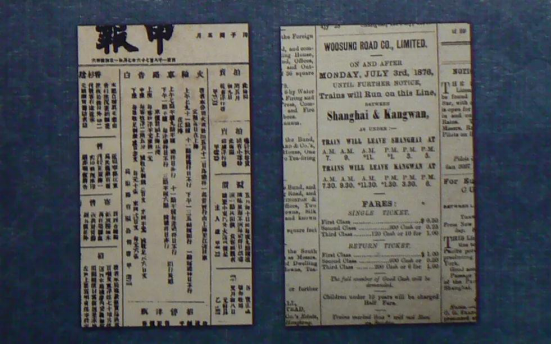
On July 1, 1876, Wusong Railway Company published China's first railway timetable; the left is a report entitled “Railway Announcement” released by Shen Bao, a newspaper.
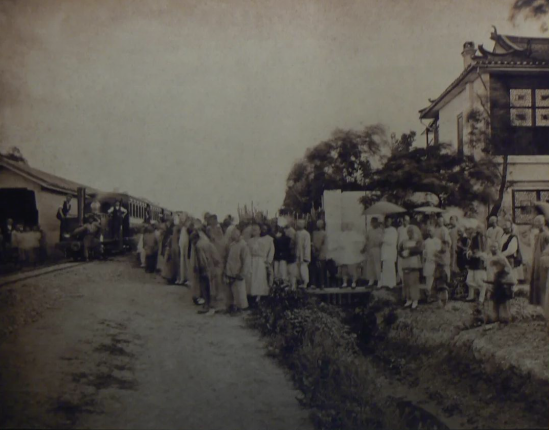
On July 3, 1876, Wusong Railway launched its opening ceremony.
The grand opening of Wusong Railway can be described as “rather spectacular” in today’s words. As reported by Shen Bao on the next day (July 4, 1876) of the official opening if Wusong Railway, “People came in crowds to take the train, mostly in upper and middle-class seats; by 13:00 of the day, the train had been fully packed, some passengers who bought upper and middle-class seats even had to take lower-class seats. People continued coming in crowds even after the train had left. They all wanted to try the novel thing they had never seen before.” Afterwards, “railway travel” became trendy. Even people who rarely went out of their homes all year long came with their families to take the train.
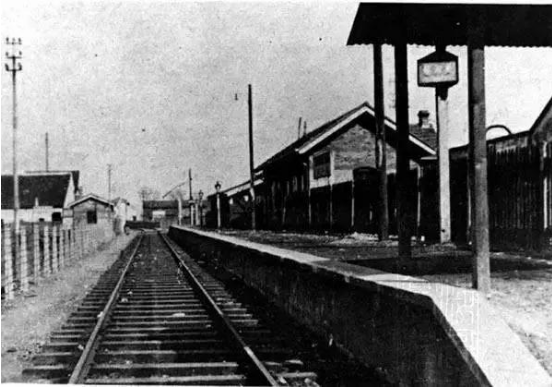
Wusong Station (Songhu Road)
Since it took great efforts for the British to build the first normally-run railway in China, the ticket prices would certainly cost a fortune. For the travel from Shanghai to Wusong, the upper-class ticket charged one yuan, the middle-class 5 jiao, and the lower-class 200 wen (1,200 wen = 1 yuan). At the time, one tam of rice was about 2 yuan. This means one upper-class ticket would cost half a tam of rice and round-trip tickets would afford a full tam of rice. Therefore, train travel was rather “expensive” at the time.
Since railways were all imported goods like vessels, guns and telegraphs, the Qing government rejected them instinctively. In their mind, these peculiar things should be shut out of the door. However, this railway had already been put in operation. When trying to negotiate with the British railway company, the Qing government received no response as the company simply ignored them.
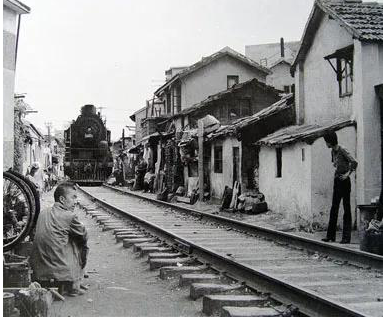
On August 3, 1876 when Wusong Railway marked its first month of operating, a man was hit and killed by the train in Jiangwan where the line had not yet officially opened. This incident stroke the locals that this black thing could kill people! Seizing this opportunity, the Qing government suspended the operation of the railway. Consequently, the Qing government and the British government started to negotiate over the ownership of the railway. The Chinese representative asked for taking the ownership back, while the British representative delayed the negotiation with various excuses. After one month of negotiation, the two sides signed an agreement on October 24, which stipulated that the Qing government would pay 28,5000 TLs. to buy back the ownership of the railway, payable in three installments over the course of the next year. The Qing government allowed the British railway company to continue work on the line over the next year, namely from October 31, 1987 to October 21, 1877.
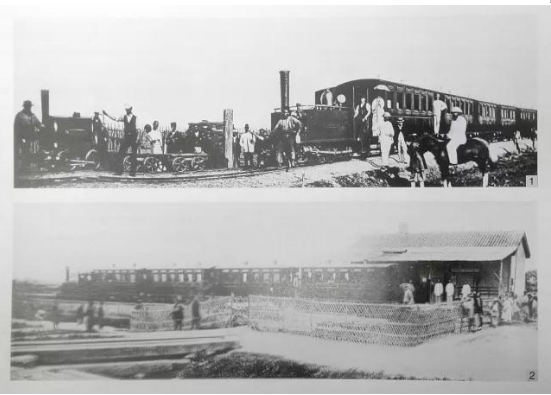
On December 1, 1876, the entire line of Wusong Railway (from Wusong to Shanghai downtown) was finally completed, becoming the main transportation between Wusong and Shanghai downtown. As of July 17, 1987, the railway had carried 161,331 passengers in its less than ten months of service, setting a transportation record in China. On October 20, 1877, Wusong Railway was terminated. On October 21 when the one-year transition came to an end, the Qing government officially took possession of Wusong Railway. Shen Baozhen, then Viceroy of Liangjiang, ordered to dismantle the rails, level out the roadbase and tear down the stations, leaving Wusong Railway entirely demolished. Ding Richang, then Governor of Fujian and Educational Director of Taiwan, transported the rails and trains to Taiwan and planned to build a railway between Tainan and Taipei. Twenty-one years later, in 1898 the Qing government, relying on its own ability and funds, built Songhu Railway along the same path as the previous Wusong Railway.
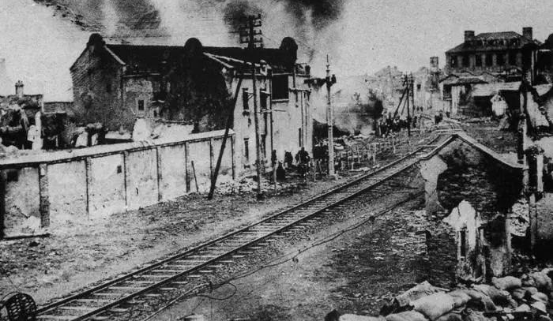
For a century thereafter, Songhu Railway witnessed the changes and development of Shanghai and went through the war fire in the Battle of Shanghai. In 1997, Songhu Railway was closed permanently with its historical mission coming to an end. The line now forms part of Line 3 of Shanghai Metro.
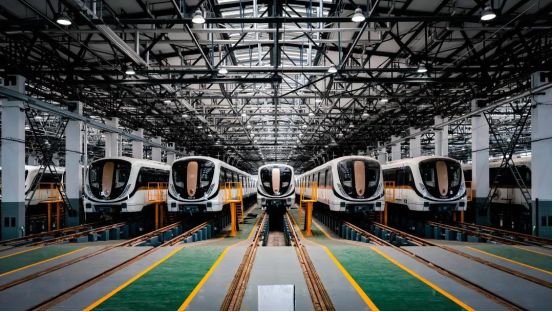
Since the reform and opening-up, Lines 1, 3 and 7 of Shanghai Metro have run through Baoshan and the Line 15 is under construction. According to the 14th five-year plan of Shanghai, Line 18 will run through Baoshan. Baoshan will then become a modern river land with convenient transportation extending in all directions.
During the 14th five-year plan period, Baoshan plans to build the North Riverside High-speed Railway and Nantong–Shanghai Railway Phase II; Baoshan’s first station for high-speed railways and its ancillary facilities are also under planning. As these moves will lead Baoshan into the “high-speed railway” era, they constitute a solid step for Baoshan to fully integrate into the national strategy of integrated development of the Yangtze River Delta.
Chronicles of Wusong Railway and Songhu Railway
Chronicle of Wusong Railway
In the 11th year of the Tongzhi reign (1872)
The American vice-consul O.B. Bradford, in the name of building a “normal road”, obtained the right to build a narrow-gauge railway from Wusong port to Shanghai, set up Wusong Road Company and began purchasing lands. Lack of money, the project was then sold to a British company that continued the construction.
In the 13th year of the Tongzhi reign (1874)
In July, the British company established Wusong Railway Company that was registered in London and set up an office there. The company then authorized Jardine Matheson as its proxy in China and sent Gabriel J. Morrison as the chief engineer and agent of Wusong Railway Company. Then, an office of Wusong Railway Company was set up in Shanghai to continue the construction.
In the second year of the Guangxu reign (1876)
On July 3, the line of Wusong Railway between Jiangwan and Shanghai was opened to passenger traffic.
On August 3, the Qing government telegraphed Sir Walter Henry Medhurst, then British Consul in Shanghai, to stop the operation.
On October 24, the Qing and British governments signed an agreement which allowed the Qing government to acquire the complete ownership of Wusong Railway with 285,000 Tls, payable in three installments over the next year; the railway would remain in operation before the payment was fully made.
On December 1, the entire line from Wusong to Shanghai was completed and opened, with a total length of 14.5 km.
In the third year of the Guangxu reign (1877)
At 12:00 of October 20, Wusong Railway was fully taken back by the Qing government after it completed its last travel. Then, the Qing government ordered to dismantle it.
On December 28, all rails of Wusong Railway were dismantled.
Songhu Railway (Songhu Branch Line, Wusong Line)
In the 21st year of the Guangxu reign (1895)
On July 9, Zhang Zhidong, then Viceroy of Huguang and Viceroy of Liangjiang, proposed to build a Huning railway to the Zongli Yamen and sent Baurath Hildebrand, a German engineer, to survey the routes.
In the 22nd year of the Guangxu reign (1896)
On February 14, Zhang Zhidong reported the survey results of Hildebrand to the central government and obtained approval for preparations by sections.
In September, Zhang Zhidong, then Nanyang Trade Minister, received the approval for constructing a railway between Wusong and Jiangning (today’s Nanjing).
In the 23rd year of the Guangxu reign (1897)
On January 3, the Qing government set up Imperial Chinese Railways (ICR), appointed Sheng Xuanhuai as the Minister of Railway Supervision and granted funds to firstly establish a railway between Wusong and Shanghai.
On February 27, groundbreaking started for the line between Wusong and Shanghai, namely Songhu Railway. Sheng Xuanhuai supervised the construction in person.
In the 24th year of the Guangxu reign (1898)
On August 5, Songhu Railway was completed.
On September 1, Songhu Railway was opened to passenger traffic, with a total length of 16.09 km.
In the 29th year of the Guangxu reign (1903)
On July 9, Sheng Xuanhuai officially signed a “Loan Contract for Huning Railway” with British & Chinese Corporation, Ltd. to borrow £ 3.25 million to merge the finished Songhu Railway into Huning Railway as the latter's branch line.
In the 30th year of the Guangxu reign (1904)
After merged into Huning Railway, Songhu Railway was renamed to “Songhu Branch Line”.
In the 31st year of the Guangxu reign (1905)
On March 21, after the construction of Huning Railway started, Wusong Machine Plant was established in the area between Wenzaobang, located in the north of Songhu Railway (Songhu Branch Line), and Zhanghuabang, for the purpose of independently manufacturing railway devices, repair machines and passenger carriages.
In the 26th year of the Republic of China (1937)
Wenzaobang wooden railway was destroyed by the Japanese during its attack on Shanghai on August 13. After that, the Japanese troops built a wooden bridge to facilitate transportation.
In the 28th year of the Republic of China (1939)
In April, the Japanese military set up Central China Railway and renamed Songhu Railway (Songhu Branch Line) to “Wusong Line”.
In the 31st year of the Republic of China (1942)
Central China Railway rebuilt the Wenzaobang wooden bridge into a steel-concrete bridge.
In the 34th year of the Republic of China (1945)
Central China Railway dismantled the section 10 km north of Hejiawan of Wusong Line. After the war, the section was rebuilt.
1949–1962
Passenger traffic and goods transportation continued in the outskirts.
1963
Passenger traffic was stopped on Songhu Railway, while goods transportation between Hejiawan and Baoshan Road continued.
1998
Shanghai Railway Administration established Shanghai Railway Orbit Traffic Development Co., Ltd. to establish Mingzhu Line (today's Line 3 of Shanghai Metro), China's first urban elevated rail.
2006
In December, Line 3 of Shanghai Metro was extended to North Jiangyang Road from Jiangwan Town, with a total length of 40.3 km.
Wusong Lighthouse
A Witness of How the City of Shanghai has Prospered on its Port
In 1412 (the 10th year of the Yongle region), to ensure the sailing safety of ships off Wusongkou, an earth hill was piled up on the southern bank of Yangtze River estuary (today’s riverside in Gaoqiao Town, Pudong) to provide aids to navigation. A beacon fire was ceaselessly lit on the top of the earth hill, becoming China’s first navigation mark. This is the origin of the name “Baoshan”, meaning a valuable hill literally.
When Emperor Yongle launched his maritime expeditions, the “Baoshan” beacon fire provided aids to navigation for Zheng He’s fleets which set off from Taicang County (today’s Taicang City) of Jiangsu Province and sailed about 15 n miles to Wusongkou. Afterward, as the river water kept flushing in from the bottom, “Baoshan” beacon hill gradually sunk into the river.
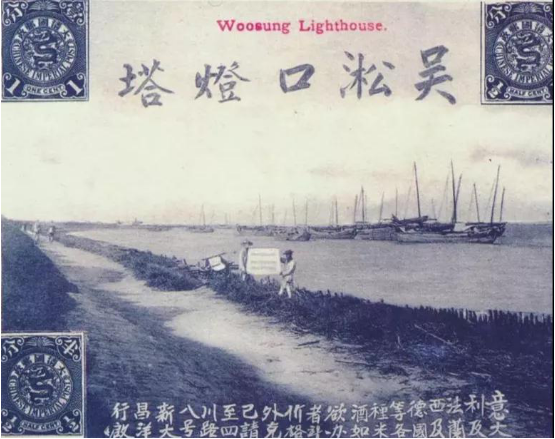
Over a century ago, the Dutch built a navigation lighthouse at the top of the left jetty of Wusongkou, becoming an important sign for the exchanges between Shanghai with the outside world. Since then, Wusong Lighthouse has been emitting flashes and using Morse Code to guide ships sailing in coastal waters regardless of their nationalities.
Since Shanghai was opened as a trading port in 1843, Wusongkou became busy again as foreign merchant ships kept sailing in and out. In 1907, the construction of the left jetty of Wusongkou kicked off according to the plan of JohannisdeRi-jke, a Dutch engineer. Completed in 1910, the left jetty had a total length of 1,395 m and emerged in the shape of a circular arc with a radius of 2.4 km and an average section width of 45 m; taking a slope of 1:10, the jetty gradually descended from the west to the east till it met the river. Constructed by East Asiatic Dredging Co., a Dutch company, the project consisted of three parts: the main jetty, a sloping seawall and a working port, also known as “Wusong Shigeng”.
To help guide the sailing of ships at night, pontoon boats were put at the terminal of the jetty to give light. In 1928, the pontoon boat on the east of the jetty was dismantled and replaced with a fixed lighthouse weighing over 20 tons to give light day and night. This is the earliest predecessor of today's Wusong Lighthouse.
After the founding of the New China, relevant departments highly valued the maintenance of the jetty. To protect the lighthouse base from being destroyed by the sinking rocks around it, the government made repairs by rock revetment twice in 1951 and 1953. In 1958, more than 300,000 m3 of sands were cleaned up at the feet of the jetty and 807 tons of riprap were used 10~20 m away from the jetty to protect the base. In 1964, Shanghai Dredging Administration conducted another survey, measurement and underwater investigation in detail, and carried out mattress revetment, rock revetment and surface repair. At last, the jetty had a total length of 720 m being reinforced, covering a size of 8,146 m2. More than 50,000 tons of riprap were used and three light beacons were newly built.
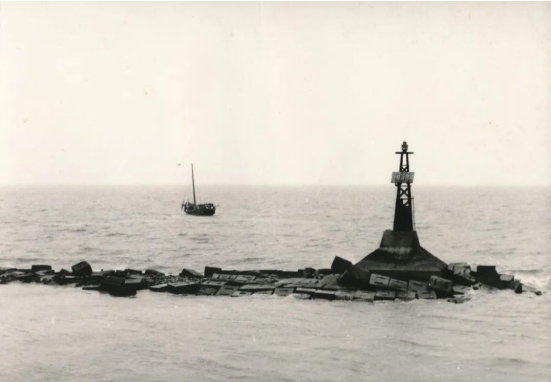
Wusongkou Lighthouse and Jetty in the 1980s
The development of Chinese navigation marks ushered in a new era after the Third Plenary Session of the 11th CPC Central Committee. In 1988, Shanghai Maritime Safety Administration rebuilt the light beacons into coning iron drums and gave them an official name, “Wusong Lighthouse”. The rebuilding kicked off on September 26, 1998 and was completed on December 29, 1999. This is how today's white steel-concrete lighthouse was born. Unmanned and equipped with a radar transponder, the lighthouse has a tower height of 20.1 m and a light height of 17.4 m, with a reaching range of 13 n miles and a backup light's reaching range of 7 n miles. From there on, Wusong Lighthouse ushered in its modern times. It has its own language, with the white light shining once every five seconds. Ships sailing within 13 n miles all can catch the light to identify the location of Wusongkou.

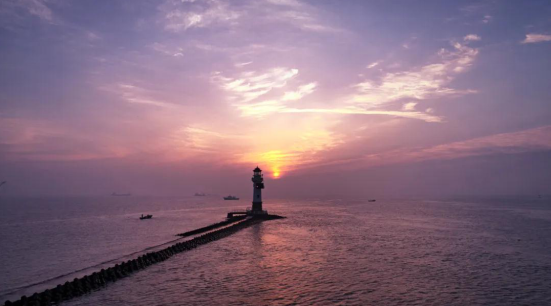
From the “Baoshan” beacon fire guiding the way ahead for Zheng He’s fleets during the Ming Dynasty to the modern Wusong Lighthouse standing in the intersection of Yangtze River and Huangpu River, the navigation mark at Wusongkou witnessed the profound changes and development of Shanghai over the last century. Today, it continues to guide ships from all over the world to the fast-changing metropolis!
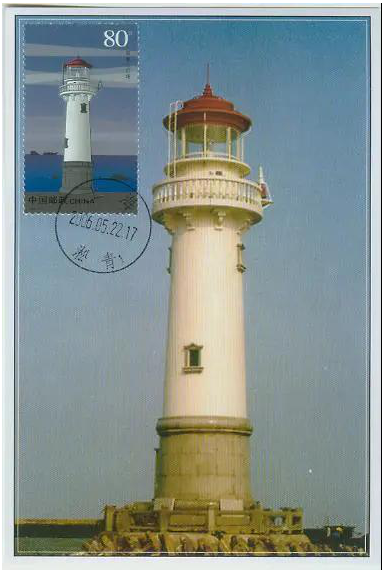
In May 2006, Shanghai held the highest-level event of the international navigation mark field, the 15th Conference of the International Association of Marine Aids to Navigation and Lighthouse Authorities (IALA). To celebrate this event, the State Post Bureau issued a special set of four stamps themed on “Modern Lighthouses”. Wusong Lighthouse was chosen, leaving its image on the world’s voyage history.
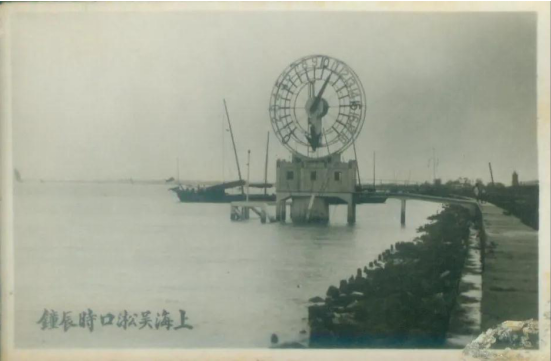
Wusong Datum
China’s First Vertical Datum
At the entrance of Wusongkou International Cruise Terminal stands a big clock. This is the newly built “Wusong Datum” square. According to research, Wusong Datum is China’s first vertical datum and originated from Baoshan.
After the First Opium War, in June 1854, the UK, the US and French ministers and consuls in Shanghai decided to introduce foreign forces and taxation bodies. For this purpose, they established a tariff management committee and concluded a Shanghai customs treaty with the local government of Shanghai, starting the period of time when the management of Chinese customs fell into the hands of foreigners.
To ensure foreign ships to safely sail through the shoal of Wusong, the former Shanghai Customs set up a tide gauge station (also called “tide test station”) at Wusongkou, about 40 km from the seaside. Externally, it was called “Wusongkou Tide Gauge Station”.
Before 1871, the former Shanghai Customs (Wusong Customs Administration) set up “Wusong Gauge Zero” for sailing and measurement. It was named “Signal Station” at the time. After 1871, annual tide information began to be reported to Shanghai Dredging Bureau. After long-term recording, the lowest tide level over 1871–1900 was determined as the gauge datum, which was named “Wusong Customs Datum”, “Wusong Datum” for short. This is the basis of the subsequent Wusong height system.
In 1900, a stone benchmark was set up within Wusong Customs Administration located on the left bank of Huangpu River estuary, which took Wusong Datum as the base for stone benchmark measurement. Each height system has its own leveling origin and determines the height of the leveling origin based on the benchmark, which is the starting point of the vertical control network. Different from the leveling origin of the national height system, the Wusong height system renames its leveling origin to datum.
In 1921, Shanghai Dredging Bureau set up a steel-concrete pile with a length of 7.32 m at the point 300 m away from the benchmark stone of Wusong Signal Station. With a bronze head and a catch basin under its surface which was covered by a cement plate, the pile measured a height of 5.1054 m above Wusong Datum, which was called “Zhanghuabang Benchmark”. Given the proximity of this point to the Yangtze River bank, starting from this point, Yangtze Technical Committee measured all way up to Yichang, a distance totaling 1,800 km or so. Based on the precise height (based on Zhanghuabang Benchmark) between Wusong and Yichang measured by Yangtze Technical Committee over 1922–1926, the Wusong height system came into being, which was commonly used by the Yangtze River region. Regions along the Yangtze River all based their measurements of terrain and hydrological station benchmark on the Wusong height system.
During 1951–1955, the Yangtze River Water Resources Committee completed the precision leveling of main truck streams and branch streams of the Yangtze River section between Wusong and Yibin, Han River, Jialing River, and Min River, providing conditions for Yangtze River measurement adjustment of the Wusong vertical control network. Thereby, the Wusong height system, as the measurement benchmark, played an important role in China's economic and social development.

宝山汇APP

上海宝山微信

上海宝山微博